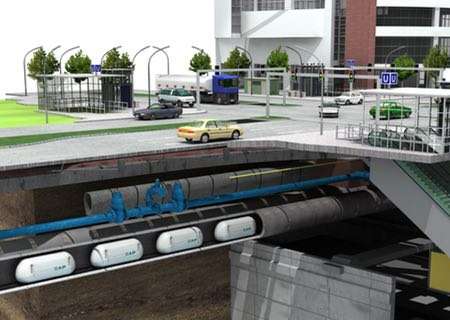High-tech pipelines aim to cut freight traffic

When it comes to moving freight around Europe, road transport remains a driving force. But trucks get stuck in traffic and pollute the environment. Now innovators are looking below the surface at a greener, more efficient alternative
Europe's freight industry is a 24/7 business. Trains, trucks, planes and boats are all involved in the complex supply chain - designed to get goods to where they should be, and on time.
That is the theory. But in reality, road freight can be held up by traffic jams, accidents and bad weather. Frustrating for the driver, but also for the supplier and customer.
But what if freight could be transported underground in our cities instead?
In the UK, private development company Mole Solutions has come up with a freight pipeline concept that uses customised capsules to move goods around. The company says pipelines would be created beside or under existing or new transport infrastructure.
In 2013, heavy goods vehicle traffic stood at 15.7 billion vehicle miles, a 0.9% increase on 2012, according to UK Department for Transport figures.
Mole Solutions says road transport dominates the country's internal supply chain, with around 67% of goods moved in this way. It adds that transport congestion costs the UK economy £31.9 billion (43.5 billion euro) per year.
As part of the company's concept, the underground freight capsules would be electric-powered and under full automatic control.
"Transporting many of the goods that society needs can be as environmentally friendly and socially acceptable as the delivery of clean water to, and dirty water from, buildings - cost effective, safe, out of sight and out of mind. Powered not by hydrocarbon fuels, but by green electricity," says Roger Miles, Managing Director of Mole Solutions.
The University of Northampton is analyzing likely demand for the Mole system.
"The opportunity to couple a low-impact, sustainable transport system with additional services, such as remote stock-holding, could transform a town centre - by allowing businesses to make better use of space," explains Professor Andrew Gough, from the university.
"A retail outlet could free up to 20 percent extra space by relocating its stockroom to the terminus of the Mole, then using the Mole to provide a 'little and often' replenishment service."
The idea of moving freight transportation underground is also being investigated in Germany as part of the CargoCap project.
It would see fully automated and electrically powered vehicles, so-called Caps, travelling through underground pipelines which have a diameter of just two metres, at a speed of 36 kilometres per hour.
"Due to its subterranean traffic routing and electrical propulsion, CargoCap makes extremely low demands on space and causes practically no emissions," explains Prof. Dietrich Stein, CEO of CargoCap GmbH.
"The negative impacts on the population caused by traffic congestion, respirable dust and noise pollution, as well as the subsequent economic consequences, are reduced."
CargoCap says the pipelines would be created by a process of pipe jacking. "This eco-friendly method of construction is one of the standard techniques in sewer construction," says Stein.
"The space above ground during construction is small. Residents and traffic are not disturbed and damage to adjacent constructions, trees and pipelines is avoided."
CargoCap has been testing out its transport concept using a model track. It is now hoping to launch a pilot project to demonstrate the functional capability.
"Debates around the world show that the common challenges when it comes to planning sustainable cities is how to reconcile demand for freight and passenger mobility, while reducing congestion, traffic accidents and environmental impact," says Stein.
"I do not know any other solution which is able to realise this."
But taking these underground concepts from design to implementation will require substantial investment. CargoCap says each kilometre of pipeline would cost around 3.2 million euros.
Provided by Youris.com




















